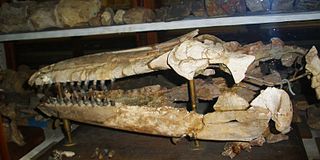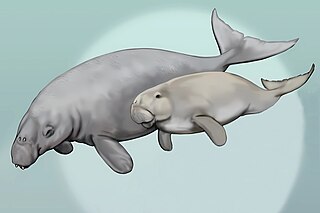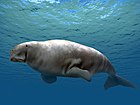
The Desmostylia are an extinct order of aquatic mammals native to the North Pacific from the early Oligocene (Rupelian) to the late Miocene (Tortonian). Desmostylians are the only known extinct order of marine mammals.

Hydrodamalinae is a recently extinct subfamily of the sirenian family Dugongidae. The Steller's sea cow was hunted to extinction by 1768, while the genus Dusisiren is known from fossils dating from the middle Miocene to early Pliocene.

Desmostylus is an extinct genus of herbivorous mammal of the family Desmostylidae living from the Chattian stage of the Late Oligocene subepoch through the Late Miocene subepoch and in existence for approximately 21.2 million years.

Sirenia is the order of placental mammals which comprises modern "sea cows" and their extinct relatives. They are the only extant herbivorous marine mammals and the only group of herbivorous mammals to have become completely aquatic. Sirenians are thought to have a 50-million-year-old fossil record. They attained modest diversity during the Oligocene and Miocene, but have since declined as a result of climatic cooling, oceanographic changes, and human interference. Two genera and four species are extant: Trichechus, which includes the three species of manatee that live along the Atlantic coasts and in rivers and coastlines of the Americas and western Africa, and Dugong, which is found in the Indian and Pacific oceans.

Eotheroides is an extinct genus of Eocene sirenian. It is an early member of the family Dugongidae, which includes the extant dugong. Fossils have been found from Egypt, India, and Madagascar. Eotheroides was first described by Richard Owen in 1875 under the name Eotherium, which was replaced by the current name in 1899.

Metaxytherium is an extinct genus of dugong that lived from the Oligocene until the end of the Pliocene. Fossil remains have been found in Africa, Europe, North America and South America. Generally marine seagrass specialists, they inhabited the warm and shallow waters of the Paratethys, Mediterranean, Caribbean Sea and Pacific coastline. American species of Metaxytherium are considered to be ancestral to the North Pacific family Hydrodamalinae, which includes the giant Steller's sea cow.

Nanosiren garciae is an extinct sirenian dugong that lived in warm shallow seas in what is now Venezuela, approximately 11.610—3.6 Ma during the Miocene and Pliocene. The species is listed in the Paleobiology Database, funded by the Australian Research Council.
Ikanogavialis is an extinct genus of gavialid crocodilian. Fossils have been found in the Urumaco Formation in Urumaco, Venezuela and the Solimões Formation of Brazil. The strata from which remains are found are late Miocene in age, rather than Pliocene as was once thought. A possible member of this genus survived into the Late Holocene on Muyua or Woodlark Island in Papua New Guinea.

Kutchisiren is an extinct genus of mammal which existed in what is now India in Khari Nadi Formation during the Miocene period. It was named by S. Bajpai, D. P. Domning, D. P. Das, J. Velez-Juarbe, and V. P. Mishra in 2010, and the type species is Kutchisiren cylindrica. It was originally named Kotadasiren gracilis in 1994, by Das and Basu.

Hemipristis serra is an extinct species of weasel shark which existed during the Miocene epoch. It was described by Louis Agassiz in 1843. While today's snaggletooth shark is not very large or dangerous, Hemipristis serra, which lived in the Atlantic Ocean during the Oligocene and Miocene, was considerably larger than its modern-day relative and had much larger teeth. Its total length is estimated to be 6 metres (20 ft). Marks made by the teeth of H. serra are often found on the bones of the dugong Metaxytherium leading some scientists to hypothesize that H. serra specialized in preying on these sirenians. In the Gatun Formation of Panama, H. serra was contemporary with pups of the large lamniform shark Otodus megalodon, and both it and the great hammerhead are theorized to have preyed on the pups of this larger shark due to their presence within the formation.

Hemisyntrachelus is an extinct genus of cetacean.

Dusisiren is an extinct genus of dugong related to the Steller's sea cow that lived in the North Pacific during the Neogene.

Miosiren is an extinct genus of manatee from the Early Miocene of southeastern England (Suffolk) and Antwerp, Belgium.
Potamosiren is an extinct genus of manatee from the Middle Miocene (Laventan) Honda Group of Colombia.
Italosiren is an extinct genus of early dugong from the Early Miocene (Aquitanian) Libano Formation in Northern Italy.
Culebratherium is an extinct genus of dugongid sirenian mammal which existed in what is now Panama during the Early Miocene. It takes its name from the upper member of the Culebra Formation of the Panama Canal Zone, in which the holotype fossil was found.

Bharatisiren is an extinct genus of mammal which existed in what is now India during the early Miocene (Aquitanian) period.
Pachyacanthus is an extinct genus of toothed whale that lived about 15.97 to 2.589 million years ago. It contains the single species Pachyacanthus suessi. The genus is known from European deposits in Hungary, Kazakhstan, Austria and Italy. The type specimen consisted of a few fragments of a rostrum and two fragmentary tympanic bullae. Skeletons from the Sarmatian of Austria did not include skulls.
Osodobenus is an extinct genus of walrus from the Miocene to Pliocene of California. Osodobenus may have been the first tusked walrus and shows several adaptations that suggest it was a suction feeder, possibly even a benthic feeder like modern species. Three skulls are known showing pronounced sexual dimorphism, with the female lacking the same tusks as the male. Only a single species, Osodobenus eodon, is currently recognized.

Sunil Bajpai is the Chair Professor of Vertebrate Paleontology in the Department of Earth Sciences, Indian Institute of Technology Roorkee. He is in service as a professor at IIT Roorkee since 1st January 1996 till 30 September 2026. He also served as the director of the Birbal Sahni Institute of Palaeosciences from January 2013 to July 2018.














